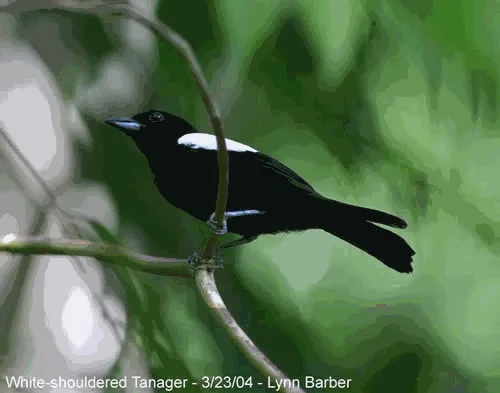 White-shouldered Tanager White-shouldered Tanager (Tachyphonus luctuosus) [order] PASSERIFORMES | [family] Thraupidae | [latin] Tachyphonus luctuosus | [UK] White-shouldered Tanager | [FR] Tangara a epaules blanches | [DE] Trauertangare | [ES] Frutero Negro | [NL] Witschoudertangare Subspecies
Physical charateristicsWhite-shouldered Tanagers are 14 cm long and weigh 14g. They are long-tailed and with a mostly black stout pointed bill. The adult male is glossy black, apart from white underwing coverts and a conspicuous white shoulder patch. The shoulder patch is the most obvious difference from the similar but larger White-lined Tanager, in which the smaller white area is rarely visible except in flight. Females and immatures have olive upperparts, yellow underparts and a grey head and neck. Listen to the sound of White-shouldered Tanager [audio:http://www.aviflevoland.nl/sounddb/W/White-shouldered Tanager.mp3]
RangeLatin America : Honduras to Bolivia HabitatCommon in tall humid forests, prefers dense foliage near forest openings. Also forest edges, clearings and coffee plantations. ReproductionThe bulky cup nest is built in low vegetation, and the female lays three brown-blotched cream eggs. Feeding habitsThese are restless birds which eat mainly insects, including stick insects , but will occasionally take fruit. They often associate with other insectivorous birds in wandering feeding flocks. ConservationThis species has an extremely large range, and hence does not approach the thresholds for Vulnerable under the range size criterion (Extent of Occurrence <20,000 km2 combined with a declining or fluctuating range size, habitat extent/quality, or population size and a small number of locations or severe fragmentation). The population trend appears to be stable, and hence the species does not approach the thresholds for Vulnerable under the population trend criterion (>30% decline over ten years or three generations). The population size has not been quantified, but it is not believed to approach the thresholds for Vulnerable under the population size criterion (<10,000 mature individuals with a continuing decline estimated to be >10% in ten years or three generations, or with a specified population structure). For these reasons the species is evaluated as Least Concern.  MigrationSedentary throughout range Distribution map |
]]>
